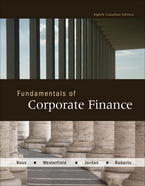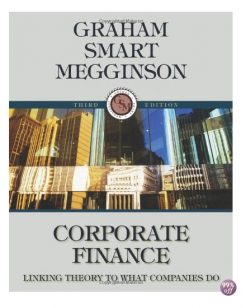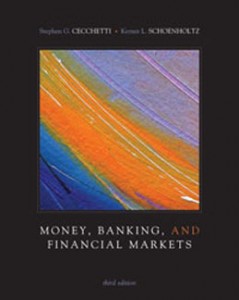Description
solutions manual Fundamentals of Corporate Finance Ross Westerfield Jordan Roberts 8th canadian edition
Delivery is INSTANT. You can download the files IMMEDIATELY once payment is done
If you have any questions, or would like a receive a sample chapter before your purchase, please contact us at inquiry@testbankcorp.com
Table of Contents
All chapters are available.
Please note that the files are compressed using the program Winzip.
Files ending with the extension (.pdf) can be opened using Adobe Acrobat Reader.
CHAPTER 1
INTRODUCTION TO CORPORATE FINANCE
Learning Objectives
LO1 The basic types of financial management decisions and the role of the financial manager.
LO2 The financial implications of the different forms of business organization.
LO3 The goal of financial management.
LO4 The conflicts of interests that can arise between managers and owners.
LO5 The roles of financial institutions and markets.
Answers to Concepts Review and Critical Thinking Questions
1. (LO1) Capital budgeting (deciding on whether to expand a manufacturing plant), capital structure (deciding whether to issue new equity and use the proceeds to retire outstanding debt), and working capital management (modifying the firm’s credit collection policy with its customers). (LO1)
2. (LO2) Disadvantages: unlimited liability, limited life, difficulty in transferring ownership, hard to raise capital funds. Some advantages: simpler, less regulation, the owners are also the managers.
3. (LO2) The primary disadvantage of the corporate form is the double taxation to shareholders of distributed earnings and dividends. Some advantages include: limited liability, ease of transferability, ability to raise capital, unlimited life, and so forth.
4. (LO4) The treasurer’s office and the controller’s office are the two primary organizational groups that report directly to the chief financial officer. The controller’s office handles cost and financial accounting, tax management, and management information systems, while the treasurer’s office is responsible for cash and credit management, capital budgeting, and financial planning. Therefore, the study of corporate finance is concentrated within the treasury group’s functions.
5. (LO3) To maximize the current market value (share price) of the equity of the firm (whether it’s publicly-traded or not).
6. (LO4) In the corporate form of ownership, the shareholders are the owners of the firm. The shareholders elect the directors of the corporation, who in turn appoint the firm’s management. This separation of ownership from control in the corporate form of organization is what causes agency problems to exist. Management may act in its own or someone else’s best interests, rather than those of the shareholders. If such events occur, they may contradict the goal of maximizing the share price of the equity of the firm.
7. (LO5) A primary market transaction.
8. (LO5) In auction markets like the Toronto Stock Exchange (TSX), brokers and agents meet at a central location (the exchange) to match buyers and sellers of assets. Physical locations for stock markets are disappearing as trading becomes more electronic. Dealer markets like Nasdaq consist of dealers operating at dispersed locales who buy and sell assets themselves, communicating with other dealers either electronically or literally over-the-counter. Dealer markets are less transparent than auction markets where trades are reported publicly almost immediately. The auction market run by the TSX is where the stocks of larger Canadian companies are traded; the TSX also operates a dealer market called the Venture Exchange for companies too small to qualify for the TSX auction exchange.
9. (LO3) Such organizations frequently pursue social or political missions, so many different goals are conceivable. One goal that is often cited is revenue minimization; i.e., provide whatever goods and services are offered at the lowest possible cost to society. A better approach might be to observe that even a not-for-profit business has equity. Thus, one answer is that the appropriate goal is to maximize the value of the equity.
10. (LO3) Presumably, the current stock value reflects the risk, timing, and magnitude of all future cash flows, both short-term and long-term. If this is correct, then the statement is false.
11. (LO3) An argument can be made either way. At the one extreme, we could argue that in a market economy, all of these things are priced. There is thus an optimal level of, for example, ethical and/or illegal behavior, and the framework of stock valuation explicitly includes these. At the other extreme, we could argue that these are non-economic phenomena and are best handled through the political process. A classic (and highly relevant) thought question that illustrates this debate goes something like this: “A firm has estimated that the cost of improving the safety of one of its products is $30 million. However, the firm believes that improving the safety of the product will only save $20 million in product liability claims. What should the firm do?”
12. (LO3) The goal will be the same, but the best course of action toward that goal may be different because of differing social, political, and economic institutions.
13. (LO4) The goal of management should be to maximize the share price for the current shareholders. If management believes that it can improve the profitability of the firm so that the share price will exceed $35, then they should fight the offer from the outside company. If management believes that this bidder or other unidentified bidders will actually pay more than $35 per share to acquire the company, then they should still fight the offer. However, if the current management cannot increase the value of the firm beyond the bid price, and no other higher bids come in, then management is not acting in the interests of the shareholders by fighting the offer. Since current managers often lose their jobs when the corporation is acquired, poorly monitored managers have an incentive to fight corporate takeovers in situations such as this.
14. (LO4) We would expect agency problems to be less severe in other countries, primarily due to the relatively small percentage of individual ownership. Fewer individual owners should reduce the number of diverse opinions concerning corporate goals. The high percentage of institutional ownership might lead to a higher degree of agreement between owners and managers on decisions concerning risky projects. In addition, institutions may be better able to implement effective monitoring mechanisms on managers than can individual owners, based on the institutions’ deeper resources and experiences with their own management. The increase in institutional ownership of stock in Canada and in the United States and the growing activism of these large shareholder groups may lead to a reduction in agency problems for Canadian and U.S. corporations and a more efficient market for corporate control.
15. (LO5) Major institutions:
Chartered banks -accept deposits and issue commercial loans, corporate loans, personal loans and mortgages.
Trust companies-accept deposits and make loans, but also engage in fiduciary activities such as managing assets for estates, registered retirement savings plans, etc.
Investment dealers -non-depository institutions that assist firms in issuing new securities.
Insurance companies -engage in indirect financing by accepting funds in a form similar to a deposit and making loans.
Pension funds -invest contributions from employers and employees in securities offered by financial markets.
Mutual funds -pool individual investments to purchase a diversified portfolio.
Hedge funds -cater to sophisticated investors and seek high returns by using aggressive financial strategies prohibited by mutual funds.
Major markets:
Money market -financial markets where short-term debt instruments are bought and sold.
Capital markets -financial markets where long-term debt and equity securities are bought and sold.
Derivatives markets – where options and futures are traded on financial instruments and commodities
Primary markets are where securities are sold for the first time; secondary markets are where outstanding securities trade.
16. (LO5) Indirect finance-funds are transferred from suppliers of capital to demanders of capital through a financial intermediary. Life insurance companies engage in indirect finance by accepting funds in a form similar to deposits and making loans.
Direct finance-funds are transferred from suppliers of capital to demanders of capital but financial intermediaries are bypassed. Bankers’ acceptances are an example of direct finance.
17. (LO5) Trends:
Financial engineering -the creation of new securities or financial processes.
Derivative securities -options, futures, forwards, and other securities whose value is derived from the price of another, underlying asset. For example, a futures contract to purchase oil sets a fixed purchase/selling price for a future date, but its value depends on the price of oil.
Regulatory dialectic -the pressures that financial institutions and regulatory bodies exert on each other. For example, when restrictions are removed, growth opportunities may increase. However, the absence of regulatory restrictions may also lead to problems such as the global financial crisis starting in 2007 caused by excessive financial leverage, so it is important that there be an appropriate level of regulatory oversight.
Corporate governance –set of processes, customs and policies affecting the way a corporation (or company) is directed, administered, or controlled. Stakeholders and regulators have become very interested in corporate governance reform with a view to control management agency costs.
These trends have made financial management a much more complex and technical activity.







Reviews
There are no reviews yet.